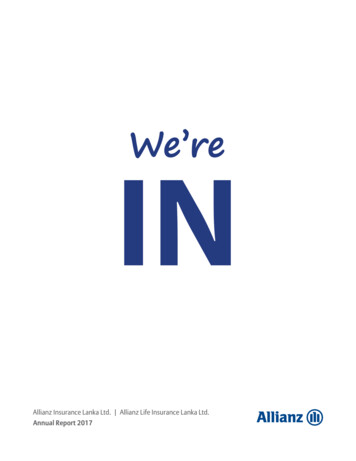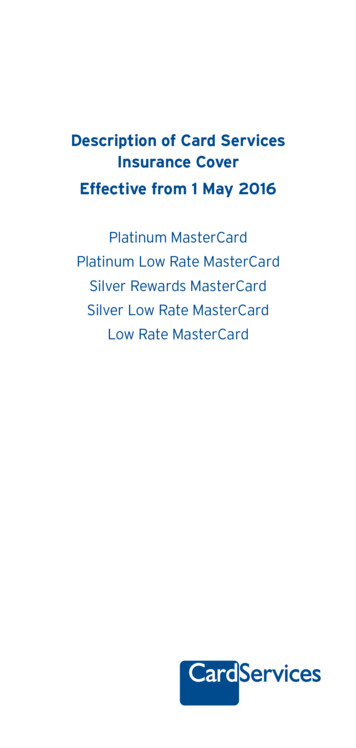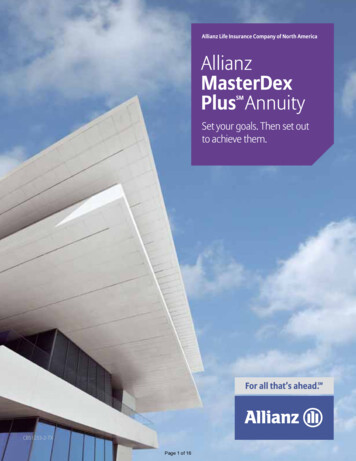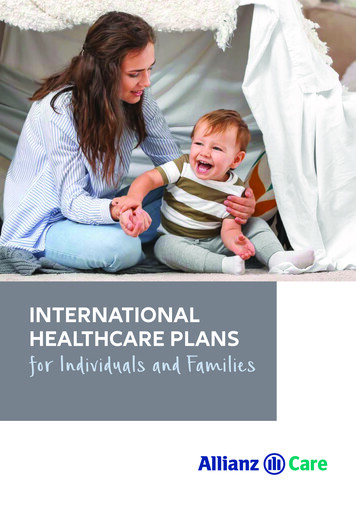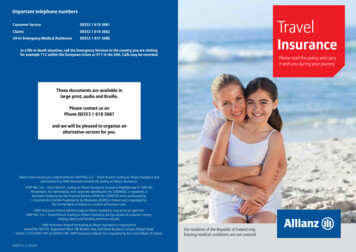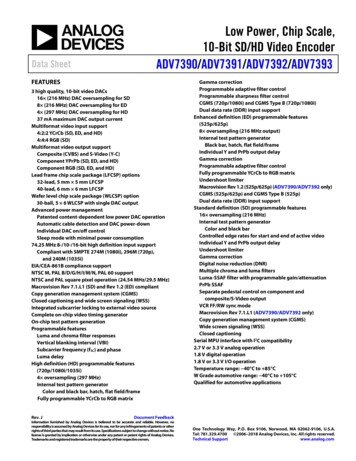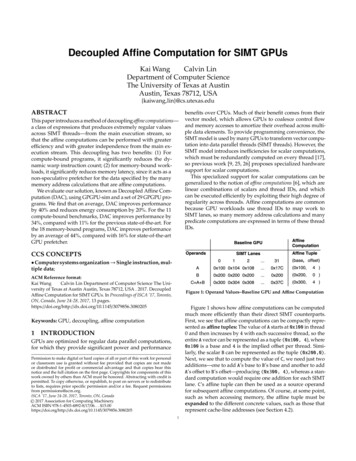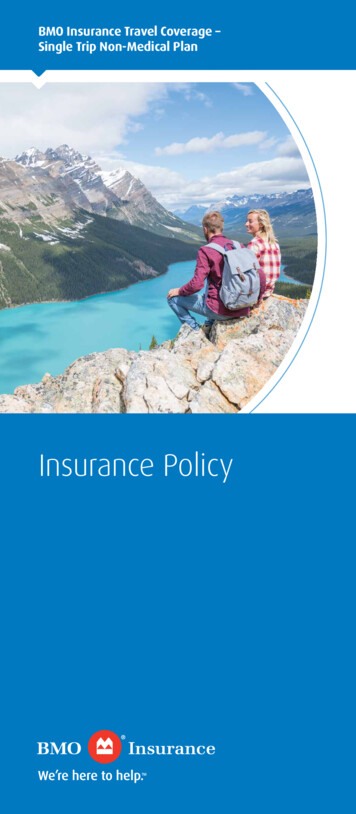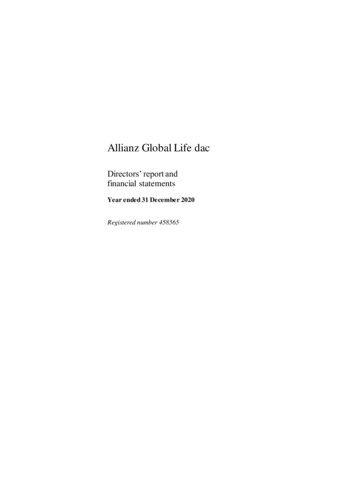
Transcription
Allianz Global Life dacDirectors’ report andfinancial statementsYear ended 31 December 2020Registered number 458565
Allianz Global Life dacDirectors’ report and financial statementsContentsPage(s)Directors and other information2-3Report of the Directors4-7Statement of Directors’ responsibilitiesIndependent auditors’ report89-13Income Statement14Statement of Other Comprehensive Income15Statement of Financial Position16-17Statement of Changes in Equity18Statement of Cash Flows19Notes to the financial statements20-631
Allianz Global Life dacDirectors and other informationDirectorsAppointedPatricia ColtonMary FultonChristian Finckh (German)Carsten Quitter (German)Giampaolo Viseri (Italian)Oliver Wohlgemuth (German)Independent non-executiveIndependent veRegistered officeMaple HouseTemple RoadBlackrockCo. DublinA94 Y9E8SecretaryFrancis O’HaraMaple HouseTemple RoadBlackrockCo. DublinA94 Y9E8Independent AuditorPricewaterhouseCoopersOne Spencer DockNorth Wall QuayDublinD01 X9R7Main BankersAllied Irish BankMerrion RoadDublinD04 NV02Resigned28/02/2021CommerzbankLeopoldstraße 23080807 MunichGermanySolicitorsDillon Eustace33 Sir John Rogerson’s QuayDublinD02 XK092
Allianz Global Life dacDirectors and other information (continued)Investment ManagersAllianz Global Investors GmbHBockenheimer Landstraße 42-4460323 FrankfurtGermanyAllianz Investment Management SEKöniginstraβe 2880802 MunichGermanyInvestitori SGR S.p.APiazza Erculea, 1520122 MilanoItalyPIMCO Europe Ltd.103 Wigmore StreetLondon W1U 1QSUnited KingdomService ProviderIrish Progressive Services International LimitedBlock C Irish Life CentreLower Abbey StreetDublinD01 A0W93
Allianz Global Life dacReport of the DirectorsThe Directors present their report and audited financial statements for the year ended 31 December 2020.Principal activity, business review and future developmentsAllianz Global Life dac (the Company) is authorised in Ireland to transact life assurance business in theEuropean Union (EU) under the Solvency II Directive (2009/138/EC) as introduced into domestic IrishLegislation by the EU (Insurance and Reinsurance) Regulations 2015, effective from 1 January 2016.The Company was incorporated on 11 June 2008 and received approval from the Central Bank of Irelandon 14 August 2008 to carry out Classes I and III Life Assurance business. The Company focused initiallyon the sale of a variable annuity product with a guaranteed minimum withdrawal benefit which isenhanced by a guaranteed minimum death benefit for some product generations. This product, alsoreferred to as classic variable annuity business, is sold via proprietary sales channels through theCompany’s French branch office since its set up in 2008, and its Italian branch office since its set up in2009. The German branch, set up in 2009, ceased selling this product in 2012. Currently the customerbase of the Company is predominantly based in France and Italy as the primary jurisdictions.Subsequently, the variable annuity business has expanded through two distinct developments. Firstly,the Company started accepting reinsurance at the beginning of 2016, taking over treaties from AllianzRe Dublin dac for variable annuity policies that were underwritten by Allianz Japan and Allianz Taiwan.These reinsurance activities were extended during 2019 through a new reinsurance treaty with AllianzPhilippines, through which the Company accepted market and biometric risks in relation to a fixed indexannuity product. Secondly, the Company leveraged its expertise in managing hedged products for afurther business expansion and successfully launched in late 2016 a new variable annuity product withguaranteed minimum accumulation and death benefits via its Italian and French branch offices, availingin both markets predominantly of proprietary sales channels of Allianz Group. Subsequently, theCompany commenced to distribute business outside of these structures and established in 2020 its firstsales partnership with an external bank in Italy. For both its primary and reinsured variable annuitybusiness, the Company continues to seek opportunities to broaden its sales capacity further through bothnew third-party distributors and geographical expansion. In parallel, it continues to work on theproducts’ features and operational aspects of their delivery to improve risk control whilst maintainingtheir value for the customer. Good progress was made in 2020 in relation to consolidation of the hedgingset-up and the strengthening of the control framework, including the launch of an enhanced reportingframework for attributing hedge profits and losses.Group life business, offering death and disability benefits for employees of corporate clients, wasintroduced to the Company’s product range in 2010. This business is underwritten via brokers throughthe Company’s head office and is currently offered on the German and Lithuanian markets. Effortscontinue to develop these two markets through innovative product features and extension of externaldistribution capacity.Protection business for retail clients was started through the Company’s Italian branch office in late2015, offering a term life product with various rider options via the internet. At the start of 2020, aniteration of this product was launched in Lithuania through the Company’s head office. Work continuesto increase sales of this product category through improved customer service and experience, with theintention to leverage on its digital platform to continue to expand geographically. In parallel, theCompany continued to successfully develop its payment protection insurance business in Italy. TheCompany’s focus in 2020 relied on increased leverage of its established broker network andenhancements of its underwriting practices.4
Allianz Global Life dacReport of the Directors (continued)Principal activity, business review and future developments (continued)In 2014, the Company entered into unit-linked business activity through its Italian branch office. Startingoff with a product for private clients which has developed highly successfully since, the Companylaunched in each of 2015 and 2016 a product for retail clients, all of which offer death benefits and aresold by Group distributors. In late 2017, the Company obtained regulatory approval to launch its Greekbranch, selling a product with a similar design to one of the Italian retail unit-linked products throughthis branch on a freedom of establishment basis with sales effectively commencing in 2020. Since 2016,the Company has the authority to operate in Cyprus on a branch basis, however to date no business hasbeen underwritten in this jurisdiction. In 2020, the Company’s head office expanded sales of this productinto the Icelandic market, again via brokers. In addition, the Company launched a new unit-linkedprivate pension plan product in Italy during the first half of 2020 which is sold through a specialiseddigital advisory firm. Also in this product segment, the Company continues to seek opportunities togrow its business into other EU markets and new distribution partnerships through both leveraging itsexisting product range and new product developments.The Company uses an internal model to calculate its Solvency Capital Requirement and has submittedregulatory returns in compliance with Solvency II requirements. Revalidations of several internal modelcomponents were conducted in 2020, confirming the appropriateness of the model subject to somerecommendations for enhancements.The Company has continued to prepare its financial statements in accordance with InternationalFinancial Reporting Standards (IFRS) as adopted by the EU.It is the Company’s objective to deliver suitable products for customer needs, to achieve a satisfactorylevel of profitability for its shareholder, and to operate in adherence with the Solvency II capital regime,whilst taking into account statutory, financial and other regulatory requirements and the reasonableexpectations of its policyholders. The Directors consider the Company is well placed to continue itsdevelopment and achieve its stated objectives.Result for the year and the state of affairs at the year-endThe result of the Company for 2020 is set out in the Income Statement on page 14 and this shows a netprofit of 9.4m after taxation (2019: net profit of 13.0m).The Company’s Statement of Financial Position is set out on pages 16 and 17, and this shows thatshareholders’ funds at the end of 2020 were 153.4m (2019: 144.1m).Note 12 to the financial statements on page 48 shows that the Company had a satisfactory level of coveron its regulatory capital at the end of 2020.The outbreak of the Coronavirus disease 2019 (COVID-19) across Europe during 2020 has had asignificant impact on financial markets, leading to very volatile market conditions and significant fall inworld equity and interest rates from late February into the latter part of 2020. As expected, theseconditions resulted in a negative impact on the short-term financial performance of the Company,especially in the form of hedge losses. Despite this volatility, a turnaround in the stock markets sawassets under management recover and grow, surpassing total assets held as at year end 2019. Distributionchannels continued to deliver on sales volumes, with an overall result largely in line with planned targets.These factors contributed to a recovery in the Company’s profitability. During this period, theCompany’s Solvency coverage ratio remained within the acceptable ranges as outlined in our RiskAppetite Statement, with both own funds and Solvency Capital Requirement at year end 2020 returningto levels experienced prior to the pandemic due to positive fund performance. Insurance operationscontinue to operate fully effective with no disruptions to customer service.5
Allianz Global Life dacReport of the Directors (continued)Result for the year and the state of affairs at the year-end (continued)The Directors believe that it continues to be appropriate for the Company’s financial statements to beprepared on a going concern basis following a review of the risks and uncertainties outlined in notes 1and 2 to the financial statements. We have not identified any material uncertainties relating to events orconditions that, individually or collectively, may cast significant doubt on the company’s ability tocontinue as a going concern for a period of at least twelve months from the date on which the financialstatements are authorised for issue. The Board expects that the Company will continue to trade and meetregulatory capital requirements for the foreseeable future.DividendsThe Company did not make any dividend payments during 2020 to its parent in respect of the prior yearor the current year (2019: 8.6m). In 2021, the Directors are not proposing to pay a dividend in respectof the year ending 31 December 2020.Risk management objectives and policiesUltimate responsibility for the Company’s internal controls, including risk management, rests with theDirectors of the Company. Management are responsible for monitoring, measuring, controlling andreporting on the risks connected with the Company’s activities on a day-to-day basis.The Directors acknowledge the importance of effective corporate governance and risk managementsystems to ensure the Company’s continuing compliance with all applicable laws and regulations andto safeguard the Company’s value and reputation. These processes are kept under review soimprovements can be made that take account of best practice, increasing regulatory requirements andthe requirements of our parent group.The Board is assisted in its governance by the operation of a number of committees, two of which, theAudit Committee and the Risk and Finance Committee, have a role in the development and monitoringof the Company’s internal control and risk management systems. Both committees are chaired by adesignated Board member and meet at least quarterly.Information on the main risks and uncertainties that the Company faces, and how these are managed, isoutlined in note 2 to the financial statements.Corporate Governance CodeThe Company is subject to and complies with the Corporate Governance Requirements for InsuranceUndertakings (the Code) as issued by the Central Bank of Ireland. The Directors note that the Companyis not subject to the requirements of Appendix I to the Code, applying only to high impact designatedinsurance undertakings.Composition of GroupThe Company is a wholly owned subsidiary of Allianz SE, a company incorporated in Germany. AllianzSE is also the ultimate holding company of the Company.DirectorsThe names of persons who were Directors at any time during 2020 are set out on page 2.Directors and secretary and their interestsThe Company has no disclosures to make under Section 329 of the Companies Act 2014 with regard tothe interests of the Directors and Secretary who held office at 31 December 2020 in the shares ordebentures or loan stock of the Company or of group companies at the beginning or end of the year.6
Allianz Global Life dacReport of the Directors (continued)Accounting recordsThe Directors believe that they have complied with the requirements of Section 281 to 285 of theCompanies Act 2014 with regard to adequate accounting records by employing personnel withappropriate expertise, providing adequate resources to the financial function and employing expertisewithin the Allianz group. The accounting records of the Company are maintained at the Company’sregistered office.Events subsequent to the year-endThere have been no events subsequent to 31 December 2020 that require adjustment to the financialstatements.Independent AuditorPricewaterhouseCoopers will continue in office in accordance with Section 383 (2) of the CompaniesAct 2014.Statement on relevant audit informationEach of the persons who are Directors at the time when this Directors’ report is approved has confirmedthat: so far as the Directors are aware, there is no relevant audit information of which the Company’sauditors are unaware; and each Director has taken all the steps that they ought to have taken as a Director in order to beaware of any relevant audit information and to establish that the Company’s auditors are awareof that information.Directors’ compliance statementThe Directors acknowledge that they are responsible for securing the Company’s compliance with itsrelevant obligations as set out in section 225 of Companies Act 2014 and confirm that: a compliance policy statement has been documented in the Company’s corporate governanceframework, setting out its internal policies with respect to compliance by the Company with itsrelevant obligations; appropriate arrangements or structures have been put in place that are, in the Directors’ opinion,designed to secure material compliance with the Company’s relevant obligations; and a review has been conducted, during the financial year to which the report relates, of anyarrangements or structures that have been put in place.AppreciationThe Directors wish to thank everyone who has contributed to the Company’s continuing development,in particular our policyholders, our employees, our distributors, our service providers and our advisors.On behalf of the boardMary FultonDirectorGiampaolo ViseriDirector18 March 20217
Allianz Global Life dacReport of the Directors (continued)Statement of Directors' responsibilitiesThe Directors are responsible for preparing the Directors' Report and the financial statements inaccordance with applicable law and regulations.Company law requires the Directors to prepare financial statements for each financial year. Under thatlaw they have elected to prepare the financial statements in accordance with International FinancialReporting Standards (IFRS) as adopted by the European Union and applicable law.Under company law the Directors must not approve the financial statements unless they are satisfiedthat they give a true and fair view of the assets, liabilities and financial position of the Company and ofits profit or loss for that year. In preparing the financial statements, the Directors are required to: select suitable accounting policies and then apply them consistently;make judgements and estimates that are reasonable and prudent;state whether they have been prepared in accordance with IFRS as adopted by the EuropeanUnion; andprepare the financial statements on the going concern basis unless it is inappropriate to presumethat the Company will continue in business.The Directors are responsible for keeping adequate accounting records which disclose with reasonableaccuracy at any time the assets, liabilities, financial position and profit or loss of the Company andenable them to ensure that its financial statements comply with the Companies Act 2014. They havegeneral responsibility for taking such steps as are reasonably open to them to safeguard the assets of theCompany and to prevent and detect fraud and other irregularities. The Directors are also responsible forpreparing a Directors’ Report that complies with the requirements of the Companies Act 2014.On behalf of the boardMary FultonDirectorGiampaolo ViseriDirector18 March 20218
Independent auditors’ report to the members of Allianz Global LifedacReport on the audit of the financial statementsOpinionIn our opinion, Allianz Global Life dac’s financial statements: give a true and fair view of the company’s assets, liabilities and financial position as at 31 December 2020and of its profit and cash flows for the year then ended; have been properly prepared in accordance with International Financial Reporting Standards (“IFRSs”) asadopted by the European Union; and have been properly prepared in accordance with the requirements of the Companies Act 2014.We have audited the financial statements, included within the Directors' Report and Financial Statements, whichcomprise: the Statement of Financial Position as at 31 December 2020; the Income Statement and Statement of Other Comprehensive Income for the year then ended; the Statement of Changes in Equity for the year then ended; the Statement of Cash Flows for the year then ended; and the notes to the financial statements, which include a description of the significant accounting policies.Our opinion is consistent with our reporting to the Audit Committee.Basis for opinionWe conducted our audit in accordance with International Standards on Auditing (Ireland) (“ISAs (Ireland)”) andapplicable law.Our responsibilities under ISAs (Ireland) are further described in the Auditors’ responsibilities for the audit of thefinancial statements section of our report. We believe that the audit evidence we have obtained is sufficient andappropriate to provide a basis for our opinion.IndependenceWe remained independent of the company in accordance with the ethical requirements that are relevant to our audit of thefinancial statements in Ireland, which includes IAASA’s Ethical Standard as applicable to public interest entities, and wehave fulfilled our other ethical responsibilities in accordance with these requirements.To the best of our knowledge and belief, we declare that non-audit services prohibited by IAASA’s Ethical Standard werenot provided to the company.Other than those disclosed in note 5 to the financial statements, we have provided no non-audit services to the company inthe period from 1 January 2020 to 31 December 2020.9
Our audit approachOverviewMateriality EUR 1.6 million (2019: EUR1.5 million). Based on circa 1% of net assets.Audit scope We performed a full scope audit of the company's financial statements, based onmateriality levels.Key audit matters Existence and valuation of financial assets. Valuation of technical provisions for insurance contracts.The scope of our auditAs part of designing our audit, we determined materiality and assessed the risks of material misstatement in the financialstatements. In particular, we looked at where the directors made subjective judgements, for example in respect ofsignificant accounting estimates that involved making assumptions and considering future events that are inherentlyuncertain. As in all of our audits we also addressed the risk of management override of internal controls, includingevaluating whether there was evidence of bias by the directors that represented a risk of material misstatement due tofraud.Key audit mattersKey audit matters are those matters that, in the auditors’ professional judgement, were of most significance in the audit ofthe financial statements of the current period and include the most significant assessed risks of material misstatement(whether or not due to fraud) identified by the auditors, including those which had the greatest effect on: the overall auditstrategy; the allocation of resources in the audit; and directing the efforts of the engagement team. These matters, andany comments we make on the results of our procedures thereon, were addressed in the context of our audit of thefinancial statements as a whole, and in forming our opinion thereon, and we do not provide a separate opinion on thesematters. This is not a complete list of all risks identified by our audit.Key audit matterHow our audit addressed the key audit matterExistence and valuation of financial assets.We gained an understanding and tested the operatingeffectiveness of management's processes and controlsRefer to note 1 (pages 25 to 28), note 2 (pages 32 to 42),note 8 (page 47), note 9 (page 47) and note 13 (pages 49 to relating to the existence and valuation of financial assets.52) to the financial statements.We obtained independent confirmation from the custodiansof nominal assets holdings at 31 December 2020,The financial assets included in the statement of financialreconciling the amounts held per the confirmations to theposition are held in the company's name at 31 Decemberaccounting records.2020 and are valued at fair value in line with IFRS.These assets comprise primarily collective investmentschemes, fixed interest securities, government and coveredbonds, equities and derivatives.We tested the valuation of the investment portfolio byagreeing the valuation of investments to independent thirdparty vendor sources.We focused on this area because it represents the principalelement of the financial statements.No matters were noted as a result of performing theseprocedures.Valuation of technical provisions for insurance contracts.Refer to note 1 (pages 24 to 25), note 1 (page 29) and note18 (pages 53 to 56) to the financial statements.With the assistance of our actuarial specialists, weconsidered the methodologies and assumptions used in thecalculation of the GMxB liabilities. We focused in10
Key audit matterHow our audit addressed the key audit matterparticular on:Provisions for life assurance contracts comprise unit-linkedliabilities equivalent to the fair value of the units allocated considering management's approach to estimatingto the policyholder (financial liabilities for life assuranceguarantee costs through the use of a stochasticpolicies where investment risk is borne by thesimulation of future financial market performance;policyholders) and a non-unit linked liability (technicalprovisions for insurance contracts). assessing the reasonableness of the economicassumptions by reference to market data; andThe technical provisions for insurance contracts primarilyrelate to guaranteed minimum withdrawal benefits, assessing the reasonableness of the mortality and lapseguaranteed minimum death benefits and guaranteedassumptions by reference to experience investigationsminimum accumulation benefits (together “GMxB”).carried out by management as part of the annualassumption setting process.The GMxB liabilities are dependent on managementjudgements in the application of valuation methodologiesWe reviewed management's analysis of the provisionand assumptions. The principal assumptions are thosemovements which involve comparison with stress tests,relating to future investment returns, discount rates,sensitivity analysis and the company’s hedging strategy.mortality and lapses. These vary by product type.We focused on the valuation of technical provisions forinsurance contracts because its determination involvessignificant judgement and is dependent upon a range ofeconomic and demographic assumptions.We also: assessed the design and tested the operatingeffectiveness of selected controls over the calculation ofthe GMxB liabilities; and tested the relevant key inputs to the company'sunderlying records.No matters were noted as a result of performing theseprocedures.How we tailored the audit scopeWe tailored the scope of our audit to ensure that we performed enough work to be able to give an opinion on the financialstatements as a whole, taking into account the structure of the company, the accounting processes and controls, and theindustry in which it operates.We performed a full scope audit of the company's financial statements, based on materiality levels.MaterialityThe scope of our audit was influenced by our application of materiality. We set certain quantitative thresholds formateriality. These, together with qualitative considerations, helped us to determine the scope of our audit and the nature,timing and extent of our audit procedures on the individual financial statement line items and disclosures and inevaluating the effect of misstatements, both individually and in aggregate on the financial statements as a whole.Based on our professional judgement, we determined materiality for the financial statements as a whole as follows:Overall materialityEUR1.6 million (2019: EUR1.5 million).How we determined it1% of net assets.Rationale for benchmarkappliedWe have selected this benchmark as, in our view, net assets is the most appropriatebenchmark given the circumstances and nature of the Company's business.We agreed with the Audit Committee that we would report to them misstatements identified during our audit aboveEUR80,000 (2019: EUR75,000) as well as misstatements below that amount that, in our view, warranted reporting forqualitative reasons.In accordance with guidance on the audit of insurers issued by the Financial Reporting Council which is generally acceptedin Ireland, we have applied a higher materiality threshold of EUR52.1 million solely for the purpose of identifying andevaluating the effect of misstatements that are likely only to lead to a reclassification between line items within assets andliabilities, in particular unit-linked investment contract assets and liabilities.11
Conclusions relating to going concernOur evaluation of the directors’ assessment of the company’s ability to continue to adopt the going concern basis ofaccounting included: obtaining management's going concern assessment for the going concern period which covers a year from thedate of approval of the financial statements; reviewing the company’s financial and solvency position and the surplus over its regulatory capital requirements; reviewing management’s Own Risk and Solvency Assessment procedures to stress test the capital position invarious adverse scenarios; considering the company’s assessment of the impact of COVID-19 on its underwriting, claims and investments; reviewing the credit rating of the company’s reinsurance counterparties. reviewing the company’s liquidity position; and reviewing the going concern disclosures included in the financial statements in order to assess whether thedisclosures are appropriate and in accordance with reporting standards.Based on the work we have performed, we have not identified any material uncertainties relating to events or conditionsthat, individually or collectively, may cast significant doubt on the company’s ability to continue as a going concern for aperiod of at least twelve months from the date on which the financial statements are authorised for issue.In auditing the financial statements, we have concluded that the directors’ use of the going concern basis of accounting inthe preparation of the financial statements is appropriate.However, because not all future events or conditions can be predicted, this conclusion is not a guarantee as to thecompany’s ability to continue as a going concern.Our responsibilities and the responsibilities of the directors with respect to going concern are described in the relevantsections of this report.Reporting on other informationThe other information comprises all of the information in the Directors' Report and Financial Statements other than thefinancial statements and our auditors’ report thereon. The directors are responsible for the other information. Ouropinion on the financial statements does not cover the other information and, accordingly, we do not express an auditopinion or, except to the extent otherwise explicitly stated in this report, any form of assurance thereon.In connection with our audit of the financial statements, our responsibility is to read the other information and, in doingso, consider whether the other information is materially inconsistent with the financial statements or our knowledgeobtained in the audit, or otherwise appears to be materially misstated. If we identify an apparent material inconsistencyor material misstatement, we are required to perform procedures to conclude whether there is a material misstatement ofthe financial statements or a material misstatement of the other information. If, based on the work we have performed, weconclude that there is a material misstatement of this other information, we are required to report that fact. We havenothing to report based on these responsibilities.With respect to the Report of the Directors, we also considered whether the disclosures required by the Companies Act2014 have been included.Based on the responsibilities described above and our work undertaken in the course of the au
Re Dublin dac for variable annuity policies that were underwritten by Allianz Japan and Allianz Taiwan. These reinsurance activities were extended during 2019 through a new reinsurance treaty with Allianz Philippines, through which the Company accepted market and biometric risks in relation to a fixed index annuity product.

